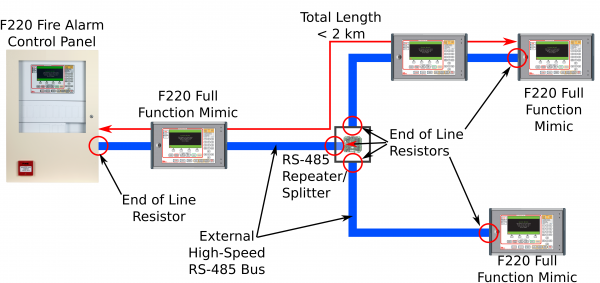News
How to Build a Trouble-Free RS-485 Bus for Pertronic Fire Alarm Systems
Tweet
The F220 has been designed to support the trend toward larger, more complex fire alarm systems. These systems collect and process a lot of information, which is why the F220 has a 115.2 kb/s External High-Speed RS-485 Bus, in addition to the 9600 bit per second Low-Speed RS-485 Bus.
Building a reliable RS-485 system requires good installation practice. The data circuit must be laid out as a point-to-point transmission line. If branches or spurs are needed, it is vital to use the Pertronic RS-485 Repeater/Splitter, which can create up to five spurs. Using the splitter eliminates communication errors on RS-485 systems with multiple spurs. The RS-485 Repeater/Splitter works equally well on low-speed and high-speed RS-485 buses.
Each RS-485 bus segment must be no more than one kilometre in length. Every bus segment must be terminated at each end with an end-of-line resistor: 90 to 100 ohms for typical fire-rated twisted-pair cable. These resistors prevent signal reflections that would cause communication errors. Only one RS-485 Repeater/Splitter can be used; the total cable length must not exceed 2 km from the panel to the far end.
When using the RS-485 power circuit to supply power to peripherals such as mimics, it is vital to allow for voltage drop. For example, the F220 Full Function Mimic needs at least 15 Volts. If the mimic is to operate normally when the panel battery falls below 19 Volts, the power circuit volt drop should be no more than 3.5 Volts. Mimics on some systems may need auxiliary power supplies.
Find out more about F220 RS-485 Mimics
 CLICK to CALL US NOW
CLICK to CALL US NOW
